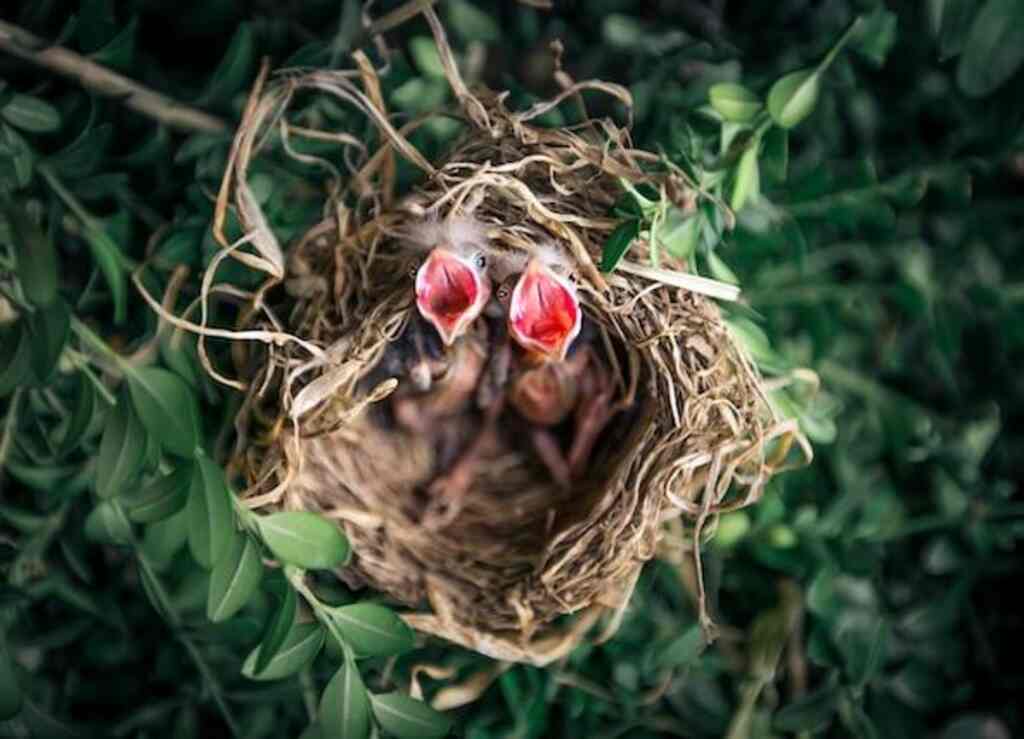Why Do Baby Birds Die In The Nest? It’s a tragic tale of tiny feathers and missed flight lessons. In this whimsical exploration, we uncover the secrets behind this puzzling phenomenon.
Discover the delicate balance of nature, the perils of sibling rivalry, and the surprising survival strategies. Get ready to dive into a world where tiny hearts beat, and fledgling dreams take flight!
Table of Contents
- 1 Exploring the Factors Behind Baby Bird Mortality
- 2 Causes of Mortality
- 3 Starvation
- 4 Developmental Problems
- 5 Predation
- 6 Illness and Disease
- 7 Environmental Factors
- 8 Nest Risks
- 9 Construction and Site Selection
- 10 Disturbance and Invasions
- 11 Abandonment and Disruption
- 12 Genetic Factors
- 13 Prevention Measures
- 14 Monitoring the Nest
- 15 Providing Food and Water
- 16 Safe Nest Site
- 17 Reducing Disturbance
- 18 Medical Attention and Care
- 19 Frequently Asked Questions
- 19.1 How do baby birds communicate with their parents while in the nest?
- 19.2 Can baby birds survive if they fall out of the nest?
- 19.3 What is the lifespan of baby birds that survive to leave the nest?
- 19.4 Do different bird species have different survival rates for their offspring?
- 19.5 Are there any natural predators that specifically target baby birds in the nest?
- 20 Conclusion
- 21 Author
Exploring the Factors Behind Baby Bird Mortality
Baby birds rely heavily on their parents for their very survival. However, not all baby birds make it out of the nest alive.
The mortality of baby birds is influenced by various factors, including starvation, developmental problems, predation, illness and disease, environmental factors, and genetic factors.
Understanding the causes of baby bird mortality can help us take measures to prevent it. Starvation is one of the leading causes of baby bird mortality.
Baby birds require frequent feeding to meet their nutritional needs, and if they do not receive enough food, they can quickly starve to death.
Developmental problems can also contribute to mortality, as some baby birds may be born with genetic defects or deformities that make it difficult for them to thrive.
Additionally, predation by predators such as cats, snakes, and other birds can pose a significant threat to baby birds.
Illness and disease can also be fatal to baby birds, particularly if they are not treated promptly.
By understanding these causes of mortality, we can take steps to prevent the premature death of baby birds in the nest.
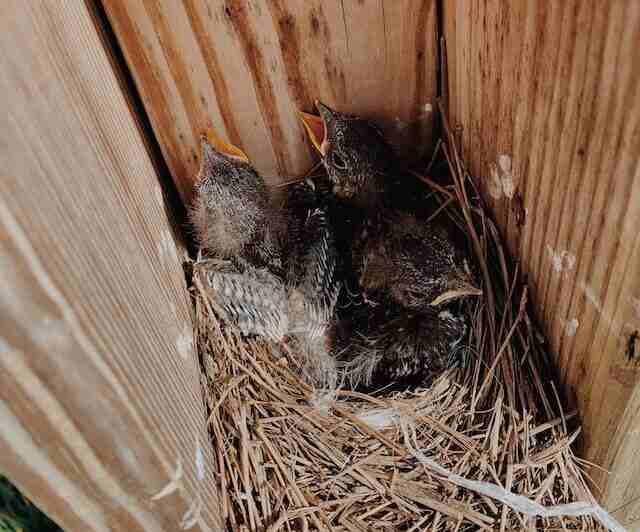
Causes of Mortality
The mortality of avian offspring is attributed to a multitude of factors, including starvation, developmental abnormalities, predation, illness, environmental influences, and genetic predispositions.
Starvation is a prevalent cause of mortality amongst baby birds, particularly in times of food scarcity or in areas with high competition for resources.
The impact of climate change on food availability can also exacerbate this issue. Developmental abnormalities, such as defects in hatching or growth, can also lead to mortality.
Parental behavior can play a critical role in ensuring proper development, with inadequate care or abandonment by parents increasing the likelihood of developmental problems.
Predation by natural predators or domestic animals is also a significant factor in baby bird mortality, as is the spread of illness and disease.
Environmental influences, such as extreme weather conditions, can also impact survival rates.
Finally, genetic predispositions can increase the likelihood of mortality, with certain genetic traits or conditions making offspring more vulnerable to these various causes of mortality.
Starvation
Starvation in young avian organisms is a significant contributor to mortality rates, as it can be caused by various factors such as insufficient food supply due to feeding behavior of parents or competition among nestlings.
Parent neglect can lead to the underfeeding of a nestling, which can result in malnutrition and eventually death.
Additionally, if food availability is low, there may not be enough resources for all nestlings, leading to competition and some individuals receiving less food.
This can result in weaker individuals being outcompeted and succumbing to starvation.
Starvation is a serious issue that can have a significant impact on nestling survival rates and highlights the importance of adequate food supply in the early stages of development.
The next major contributor to nestling mortality is developmental problems, which will be discussed in the subsequent section.
Developmental Problems
Developmental problems in avian offspring can lead to mortality rates, as they may arise due to genetic factors or environmental influences during embryonic development, hindering proper growth and development of the nestling.
Early intervention is crucial to ensure that the nestling has the best chance of survival.
Genetic disorders can be an underlying cause of developmental problems, and it is important to identify these disorders early on to provide appropriate care.
Additionally, care practices, such as providing adequate warmth and nutrition, can help mitigate the effects of developmental problems.
However, if the problem is severe, the nestling may not be able to survive. Thus, it is essential to monitor the nest closely and seek medical attention if necessary.
Understanding the potential risks of developmental problems and taking appropriate measures can help reduce mortality rates in baby birds.
As such, it is important to consider other factors that may contribute to mortality rates in baby birds, such as predation.
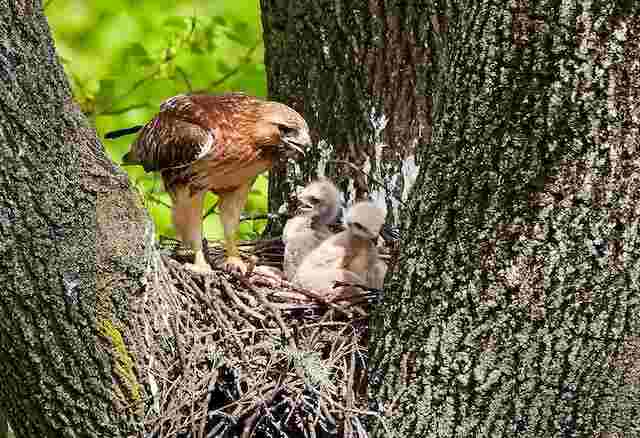
Predation
One significant factor contributing to avian offspring mortality rates is predation, which can be influenced by various environmental and ecological factors.
Identifying common predators is essential in implementing preventative measures against predation. Common predators of baby birds include snakes, squirrels, raccoons, and cats.
However, the impact of human activity on predation rates cannot be understated.
Increased urbanization and habitat fragmentation can lead to an increase in predators such as domestic cats and even some birds.
Providing a safe nest site and reducing human disturbance can help reduce predation rates. However, it is important to note that predation is a natural occurrence in the wild and cannot be eliminated entirely.
In the next section, we will explore illness and disease as another factor contributing to baby bird mortality rates.
Illness and Disease
Illness and disease pose a significant threat to the survival of avian offspring, acting as a lurking predator waiting to strike at any moment.
To prevent illness, it is crucial to provide a clean and dry nest environment, free of feces and other debris that can harbor bacteria and fungi.
Common diseases that can affect baby birds include avian pox, canary pox, avian influenza, salmonellosis, and trichomoniasis.
Early detection techniques include monitoring the nest for any signs of illness such as lethargy, lack of appetite, and abnormal droppings.
Immediate medical attention should be sought if symptoms are detected to prevent the spread of disease to other nestlings.
However, some diseases may be difficult to detect and may not show symptoms until it is too late.
Therefore, it is essential to provide a healthy and stress-free environment for baby birds to reduce the risk of illness and disease.
Environmental factors, such as extreme weather conditions and pollution, can also contribute to the susceptibility of avian offspring to illness and disease.
Environmental Factors
Illness and disease are not the only factors contributing to the mortality of baby birds in the nest.
Environmental factors such as nest temperature, air pollution, and climate change can also play a significant role.
Nest temperature is crucial for the survival of baby birds, and any deviation from the optimal temperature can lead to their death.
Air pollution caused by human activities can also have adverse effects on the respiratory system of birds, leading to respiratory diseases and death.
Climate change can cause extreme weather events such as heatwaves, droughts, and storms, which can disrupt the nesting environment and reduce the availability of food, ultimately leading to the death of baby birds.
Therefore, it is essential to consider these environmental factors when attempting to prevent the mortality of baby birds in the nest.
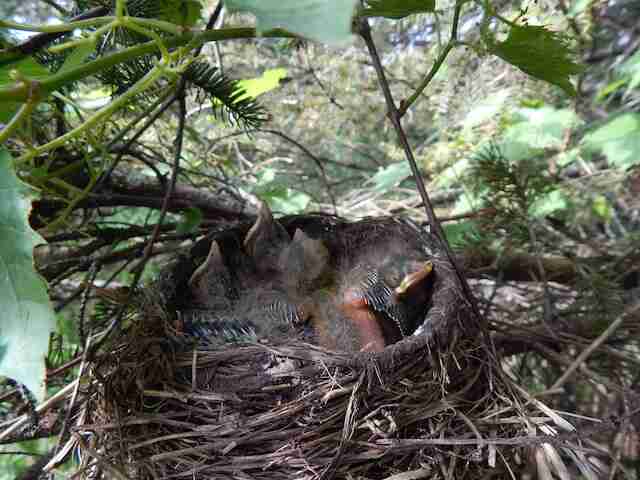
Nest Risks
The risks associated with nest construction, site selection, disturbance, invasion, abandonment, and disruption are significant factors contributing to the mortality of avian offspring.
While predator avoidance is a key consideration in choosing a nest site, the type and amount of nest material used can also affect the survival of young birds.
Additionally, climate adaptation must be taken into account to ensure that the nest provides adequate protection from the elements.
Disturbance and invasion by humans or other animals can cause stress and potentially harm the young birds, while abandonment and disruption of the nest can lead to starvation or exposure.
To reduce the risk of mortality due to nest risks, it is important to monitor the nest regularly, provide a safe and suitable nest site, and minimize disturbance and disruption.
Next, we will explore the importance of proper nest construction and site selection in further detail.
Construction and Site Selection
Proper nest construction and site selection are crucial factors that can significantly impact the survival of avian offspring, as they provide protection from environmental elements and predators, and offer a safe and secure environment for the development of young birds.
Factors affecting nest construction and site selection include the availability of suitable materials, such as twigs, grass, and feathers, which determine the strength and durability of the nest.
The nest’s location also plays a critical role in its success, as it should be situated in an area that is not easily accessible to predators and provides sufficient food and water sources.
Human activities, such as deforestation and construction, can negatively affect nest sites, leading to a decline in avian populations.
The importance of nest materials and site selection cannot be overstated, as they significantly impact the survival and growth of avian offspring.
The next section will discuss disturbances and invasions that can also impact the survival of baby birds in the nest.
Disturbance and Invasions
Disturbances and invasions pose significant threats to the survival of avian offspring, as they can disrupt the delicate balance within the nest and expose young birds to harsh environmental conditions, making them vulnerable to predators and reducing their chances of successful fledging.
Ensuring privacy for the nest is crucial to minimize disturbances and invasions. Nesting material should also be carefully chosen to provide insulation and protection for the young birds.
Parental care plays an essential role in protecting the nest from predators and preventing disturbances.
Human intervention, such as checking the nest or trying to handle the chicks, can disrupt the parents’ care and make them abandon the nest.
Other potential invaders include other bird species that may compete for resources or, in some cases, prey on the nestlings.
Overall, minimizing disturbances and invasions is crucial to ensure the survival of baby birds in the nest and increase their chances of successful fledging.
The next step is to discuss the impact of nest abandonment and disruption on chick mortality.
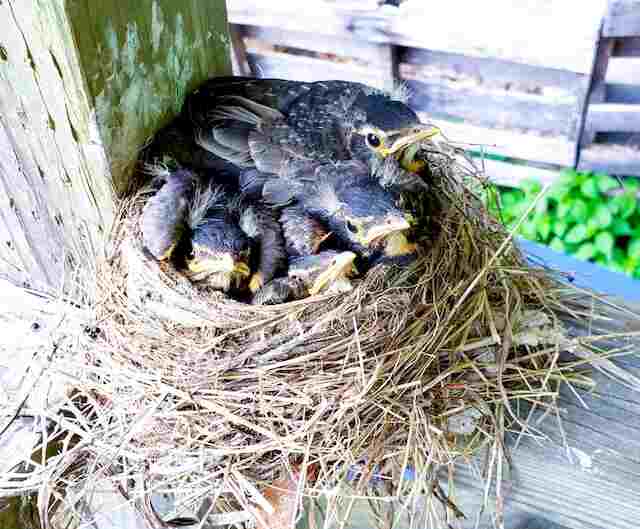
Abandonment and Disruption
Disruptions and abandonment in nests are distressingly common occurrences that can lead to the death of baby birds.
Nest abandonment is a result of a variety of factors, including changes in the environment, a lack of food resources, and predation.
Disruption in the nest can occur due to human interference or natural causes, such as harsh weather conditions.
To prevent abandonment and disruption in nests, it is crucial to provide a safe and secure nesting site with adequate food and water resources.
Monitoring the nest can also help identify any potential problems early on and allow for prompt intervention.
Despite these preventative measures, genetic factors can also play a role in the mortality of baby birds.
Genetic Factors
Understanding the role that genetic factors can play in the mortality of avian offspring is crucial for developing effective conservation strategies.
Inheritance patterns, genetic mutations, and genetic disorders can all contribute to the death of baby birds in the nest.
Some genetic mutations may lead to developmental problems in offspring, making them more susceptible to illness or predation.
Additionally, certain inherited disorders may affect the ability of parent birds to care for their young or produce viable offspring.
It is important to consider genetic factors when studying and addressing the mortality of baby birds, as it can provide insight into both short-term and long-term conservation efforts.
Ultimately, identifying and addressing genetic issues can help prevent unnecessary deaths and lead to healthier populations of birds in the future.
This understanding can inform and guide prevention measures, such as providing medical attention and care to address genetic disorders in parent birds or their offspring.
Prevention Measures
One effective approach to addressing mortality in avian offspring is to implement prevention measures, such as providing a safe and secure nest site, monitoring the nest regularly, and providing food and water when necessary, which can reduce the mortality rate of young birds by up to 50%.
Breeding behavior and parental care play a crucial role in the survival of baby birds, and habitat management can significantly impact their chances of survival.
Providing a suitable nest site that is protected from predators, weather, and other disturbances is crucial for young birds to thrive.
Regular monitoring of the nest can help identify any potential problems or threats and allow for timely intervention to prevent mortality.
Additionally, providing adequate food and water can help ensure that the young birds have the necessary resources to grow and develop.
By implementing these prevention measures, avian offspring mortality can be significantly reduced, allowing more young birds to survive and thrive.
In the next section, we will discuss the importance of monitoring the nest in more detail.
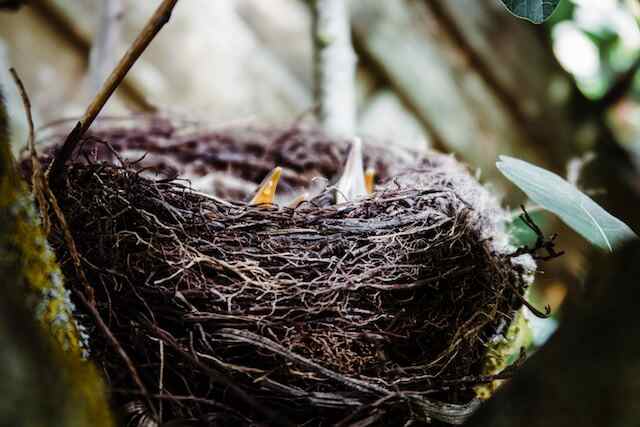
Monitoring the Nest
Monitoring the nest is a crucial aspect of avian offspring management that allows for timely identification of potential problems or threats, and facilitates effective intervention to prevent mortality and promote the survival and growth of young birds.
Nest monitoring techniques involve observing the nest and its contents, including the number and health of the chicks, the presence of predators or parasites, and any signs of distress or disease.
Regular monitoring has several benefits, including the ability to detect and address problems early, reducing the risk of mortality and improving the overall health and well-being of the chicks.
Early detection through monitoring is particularly important, as it allows for prompt action to be taken to address any issues before they escalate.
This can include providing medical attention, removing parasites or predators, or adjusting the nest environment to ensure the chicks’ safety and comfort.
Effective monitoring can also help to ensure that the chicks receive adequate food and water, which will be discussed in the subsequent section.
Providing Food and Water
Ensuring the sustenance of avian offspring is a fundamental necessity for their survival and growth, as providing nourishment during the early stages of development is akin to planting seeds for a flourishing garden.
A feeding schedule must be established to ensure that the baby birds receive the appropriate amount of food at the right time. Water sources must also be provided to keep the young birds hydrated.
The nutritional needs of the baby birds must be taken into consideration, as different species may have varying requirements. Providing a balanced diet with the necessary nutrients is crucial for their survival.
Without proper nourishment, the birds may suffer from malnutrition and become more susceptible to illness or death.
Once feeding and water sources are established, attention must be given to selecting a safe nest site, as this will further ensure the survival of the offspring.
Safe Nest Site
Selection of a secure location for the nest is crucial in mitigating risks to avian offspring and promoting their survival.
Factors affecting the safety of the nest site include the presence of predators, exposure to harsh weather conditions, and accessibility to humans and other animals that may cause disturbance.
Choosing materials for the nest construction that blend well with the surrounding environment can also improve concealment and reduce the risk of detection by predators.
Importance of location in the survival of avian offspring cannot be overstated.
Nests placed in areas with sufficient cover, such as dense vegetation, are less likely to be disturbed by predators and other natural elements.
In contrast, nests placed in open areas are more vulnerable to predation and harsh environmental conditions.
Therefore, selecting a safe nest site is an important step in ensuring the survival of baby birds.
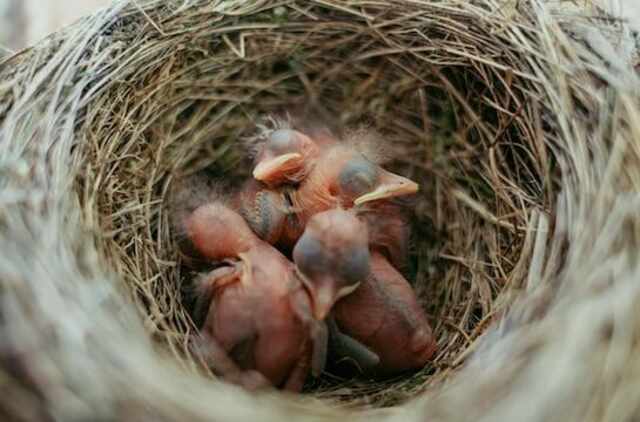
Reducing Disturbance
Minimizing interruptions and disturbances to the nesting environment is crucial for the survival of baby birds.
Noise control is a crucial element in reducing nest disturbance because birds are highly sensitive to noise.
Nest location optimization is also critical because birds are more likely to abandon nests that are too close to human activity or in unfavorable environments.
To evoke an emotional response in the audience, it is essential to note that even the slightest disturbance can have a severe impact on the survival of the avian offspring.
For instance, human activity near the nest can lead to the mother bird abandoning the nest.
Similarly, predators can be attracted to the scent of humans or other animals, leading to the death of the baby birds.
Moreover, disturbances can delay the development of the baby birds, making them more vulnerable to environmental and genetic factors.
Therefore, it is crucial to reduce nest disturbance to increase the chances of survival of baby birds.
The next step is to provide medical attention and care to the baby birds to prevent mortality.
Medical Attention and Care
Medical attention and care are crucial in increasing the survival rates of avian offspring, as they provide the necessary treatment to combat illnesses and developmental problems that pose a significant risk to their health and well-being.
Vet visits play a crucial role in identifying and treating illnesses and injuries that can lead to mortality, while providing nutritional support helps to ensure that the birds receive the necessary nutrients for growth and development.
Disease prevention is also essential, as it helps to minimize the risk of infections that can cause significant harm to the birds.
Through regular check-ups and proper care, avian offspring can thrive and overcome the various challenges that they face in their early life stages.
| Medical Attention and Care | Benefits |
|---|---|
| Vet Visits | Identification and treatment of illnesses and injuries |
| Nutritional Support | Ensuring proper growth and development |
| Disease Prevention | Minimizing the risk of infections |
| Regular Check-ups | Maintaining overall health and well-being |
| Proper Care | Providing a safe and healthy environment |
Frequently Asked Questions
How do baby birds communicate with their parents while in the nest?
Nest communication in baby birds involves a complex system of vocal cues and body language that allows them to communicate with their parents while in the nest.
Vocalizations can be used to signal hunger, discomfort, or distress, while body language such as opening their beaks or flapping their wings can indicate a need for attention or food.
Parents are able to interpret these cues and respond accordingly, providing the necessary care and support for their offspring.
Research has shown that this communication is not only important for the survival of the individual birds, but also for the overall success of the entire bird population.
Understanding the intricacies of nest communication can provide valuable insights into the behavior and development of baby birds.
Can baby birds survive if they fall out of the nest?
Surviving falls from the nest is a daunting task for baby birds, but it is not an impossible feat. In fact, studies have shown that up to 50% of baby birds that fall out of the nest can survive with proper care and attention.
Some species, such as songbirds, have developed survival instincts that allow them to leave the nest and hide until their parents return with food. However, for those that are unable to leave the ground, parental care is crucial for survival.
Parent birds will continue to feed and care for their fallen offspring, even if they are not in the safety of the nest. With the right conditions, baby birds can overcome the odds and thrive despite a fall from the nest.
What is the lifespan of baby birds that survive to leave the nest?
The survival rate of baby birds that leave their nest depends on various factors such as their growth stages and parental care.
During their early stages, baby birds are vulnerable to various environmental factors such as predation, starvation, and illness.
However, with proper parental care, these risks can be minimized.
As the birds grow and develop, their chances of survival increase, and they become more capable of finding food and avoiding danger.
The lifespan of baby birds that successfully leave the nest varies depending on their species, with some living only a few years, while others can live for decades.
Overall, the survival rate of baby birds is heavily dependent on the quality of care provided by their parents and the challenges they face in their environment.
Do different bird species have different survival rates for their offspring?
Nestling mortality is a common occurrence among birds, with various factors such as environmental conditions, developmental problems, and predation leading to the death of many young birds before they leave the nest.
Parental care plays a crucial role in determining the survival rates of offspring, as different bird species exhibit varying levels of parental investment.
Species diversity also plays a significant role in nestling mortality rates, with some bird species being more successful at raising offspring than others.
Studies have shown that some bird species exhibit higher survival rates for their offspring due to their unique nesting behaviors and parental care strategies.
For instance, some species provide more food and protection for their young, while others construct more robust nests that protect their offspring from environmental factors and predators.
Ultimately, understanding the factors influencing nestling mortality and species diversity can help to inform conservation efforts for bird populations worldwide.
Are there any natural predators that specifically target baby birds in the nest?
Predator identification is crucial in understanding the survival strategies of baby birds in the nest.
Nesting behavior plays a significant role in determining the vulnerability of baby birds to predators.
Some predators, such as snakes and raccoons, are known to specifically target baby birds in the nest.
These predators are attracted to the scent of the nest and the sounds of the baby birds.
To counteract this, some bird species have developed survival strategies such as building nests in hard-to-reach locations or using camouflage to hide the nest.
However, these strategies are not foolproof, and many baby birds still fall prey to predators.
Understanding the predator identification and nesting behavior of different bird species can aid in the development of effective prevention measures to reduce baby bird mortality.
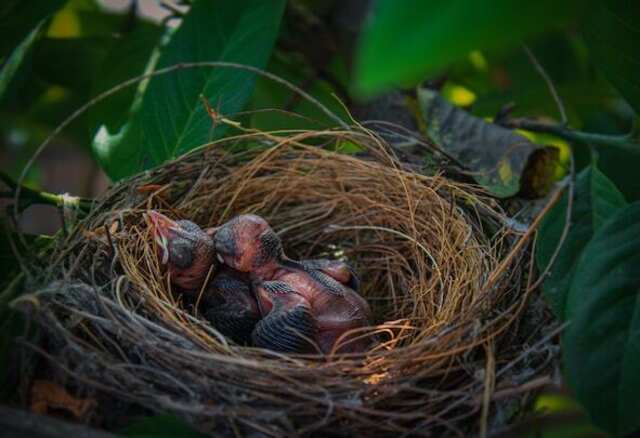
Conclusion
Baby bird mortality is a complex issue that can be caused by a variety of factors.
Some of the most common causes of mortality include starvation, developmental problems, predation, illness and disease, environmental factors, and genetic factors.
While it is impossible to completely eliminate these risks, there are steps that can be taken to reduce the likelihood of baby bird mortality.
Providing food and water, ensuring a safe nest site, reducing disturbance, and seeking medical attention and care when necessary are all important steps that can be taken to increase the chances of baby bird survival.
By understanding the causes of baby bird mortality and taking proactive measures to mitigate these risks, we can help to ensure that more of these fragile creatures are able to thrive and flourish in the wild.
Future research and education efforts may help to further improve our understanding of these issues and develop new strategies for promoting the health and well-being of baby birds.

